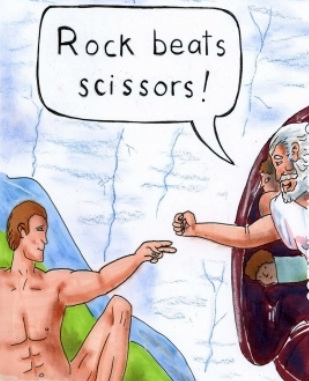Scramblin' thru... the Renaissance
And you thought you could paint...
The Renaissance was a series of cultural, literary, artistic, scientific, military, and religious movements from 1300-1600. It began in Italy before expanding into Europe. Italian cities had prospered during the Crusades from the influx of Crusaders that stopped off to be "blessed" by the Pope and who used Rome as a meeting place before leaving for the Middle East. Italians now had extra money to invest in the arts, education, and exploration. People of the Renaissance studied the civilizations of Ancient Greece and Rome and believed that their own cultural achievements rivaled those of the past.
Their thinking was also influenced by the concept of humanism, which focused on the individual. Humanists believed society could be improved and problems could be eliminated through education. This relied on teachings from ancient texts and included the study of poetry, history, and philosophy. During the Renaissance, Western Europeans began to think of themselves in new ways, a change reflected by innovations in the creative arts. A resurgence of writing in Latin took place. Painting and sculpture devoted attention to the natural world and tried to represent human emotion. Architecture abandoned the Catholic Church's Gothic style and adopted the simplicity and balance of classical forms. The struggle for supremacy between church and state became a fixture of European history during the Renaissance. Throughout Europe, Christianity found itself challenged and, finally, reformed. No single event can put the restlessness of this period into better perspective than the first voyage of Christopher Columbus. Spurred on by national rivalry and commercial interest, the Spanish monarchy sponsored the speculation of an Italian navigator. A "New World" lay to the west. Horizons were widening, and people were simply curious. |
Renaissance means "rebirth". The idea of rebirth stems from the belief that Europeans had rediscovered the superiority of Greek and Roman culture after many centuries of what they considered "intellectual and cultural decline" during the Middle Ages (a.k.a. the Dark Ages).
The preceding era, which some historians begin with the fall of the Western Roman Empire in 476 AD, became known as the Middle Ages to indicate its position "between the classical and modern worlds".
The dates of the Late Middle Ages (1300-1450) and the start of the Renaissance overlap, showing a gradual transformation instead of an abrupt stop and start.
The Teenage Mutant Ninja Turtles (or TMNT as they're known on the street) are a team of 4 teeange turtles that are trained by their rat sensei, eat pizza, live in the sewers, battle crime, and are named after Renaissance artists (Leonardo, Michelangelo, Donatello, and Raphael). Created in 1984, these mutant turtles grew in popularity during the late 1980s and early 1990s. And yes, Dr. Hartnell still has his TMNT action figures. And no, you may not play with them. Ever.
|










